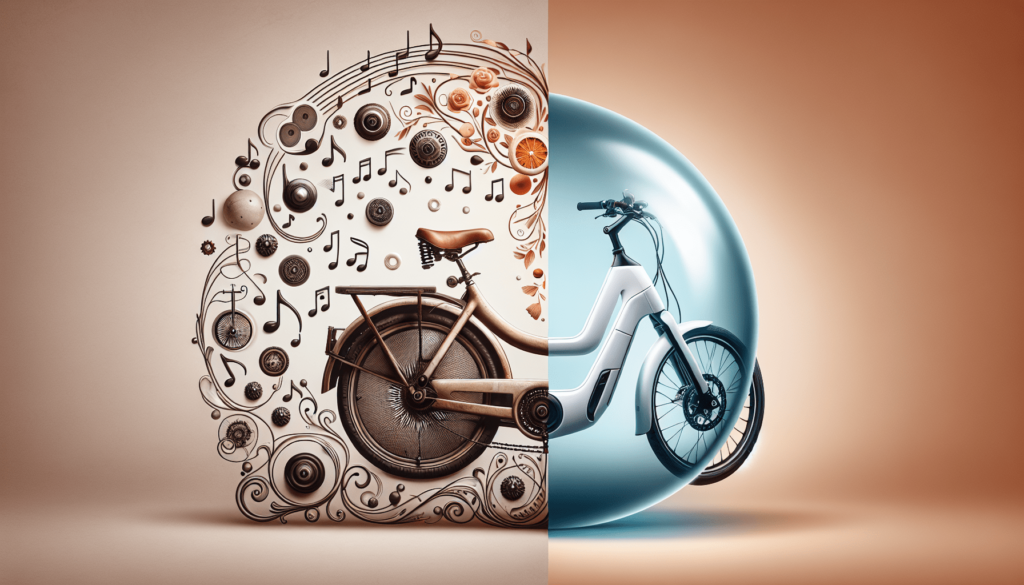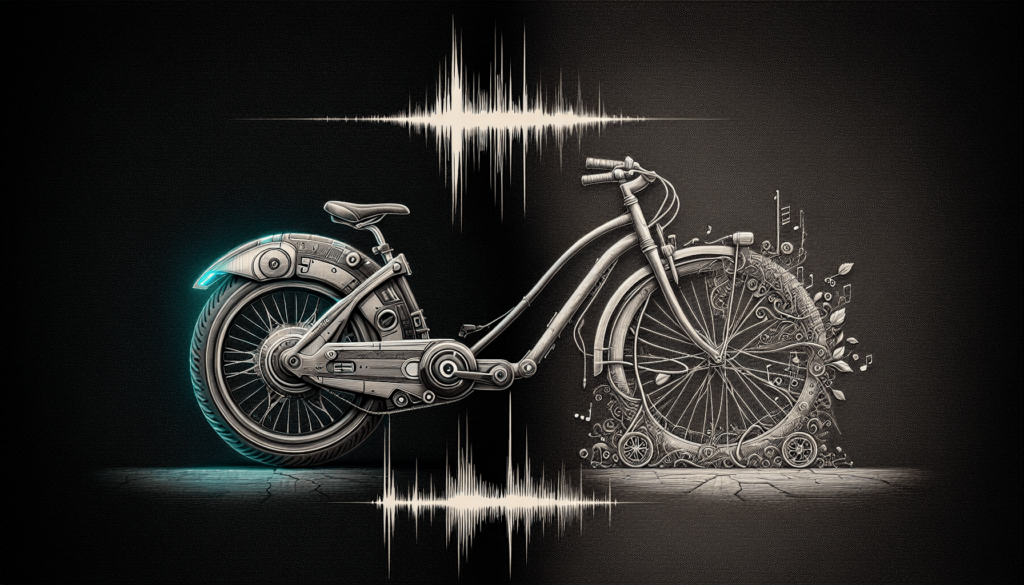In the world of bicycles, there has been a recent surge in popularity for electric bikes, or e-bikes, which rely on a battery-powered motor for assistance. With their increasing presence on city streets and countryside trails, a question arises: are e-bikes quieter than traditional bicycles? This article will explore the noise levels of e-bikes compared to their conventional counterparts, delving into the mechanics and technology that contribute to their sound production. Whether you’re a cycling enthusiast or simply curious about the differences between e-bikes and traditional bicycles, this article will provide an insight into the noise factor of these two modes of transportation.

Noise Level Comparison
Noise generated by e-bikes
E-bikes, also known as electric bicycles, have gained popularity in recent years due to their ability to provide a convenient and eco-friendly mode of transportation. One common question that arises when comparing e-bikes to traditional bicycles is whether they are quieter in comparison. To better understand the noise levels generated by e-bikes, it is important to examine the different factors that contribute to the overall noise produced.
Noise generated by traditional bicycles
Traditional bicycles, powered solely by human effort, have been a staple of transportation for many years. While they are generally considered to be quiet, especially in comparison to motorized vehicles, they can still generate some level of noise. Factors such as the chain, wheels, and riding surface all play a role in the noise levels produced by traditional bicycles.
Factors Affecting Noise Level
When comparing the noise levels of e-bikes and traditional bicycles, several factors come into play. The most significant factors that affect the noise level include the motor, chain, and wheels of the e-bike, as well as the quality of the chain, condition of the drivetrain, and the type of tire and pressure on traditional bicycles.
Motor noise
One of the primary sources of noise in e-bikes is the electric motor. The noise generated by the motor can vary depending on its type and location. Different types of e-bike motors include internal gear hub motors, mid-drive motors, and hub motors, each with their own noise characteristics. Internal gear hub motors tend to be quieter due to their enclosed design, while mid-drive motors may produce more noise as they interact directly with the drivetrain. Hub motors, located in the wheels, can also generate noise but are generally quieter than mid-drive motors.
Chain noise
The chain of an e-bike can also contribute to the overall noise level. Factors such as the quality of the chain and the condition of the drivetrain can affect how silently the chain operates. A well-lubricated chain and a properly maintained drivetrain can significantly reduce chain noise. Additionally, some e-bikes may be equipped with a belt drive system instead of a chain, which can further minimize noise levels.
Wheel noise
The type of tire and the pressure of the wheels can impact the noise generated by both e-bikes and traditional bicycles. Fat or knobby tires may produce more noise due to the increased contact area and rolling resistance. Conversely, thinner and smoother tires tend to generate less noise. Additionally, the condition of the wheel bearings can also affect the noise level. Properly maintained and well-lubricated bearings can help reduce wheel noise.
Quietest Type of E-bike
When comparing different types of e-bikes, it is essential to consider the overall noise level. While noise levels can vary between models and manufacturers, some general trends can be identified.
Comparison of different e-bike types
Among the various types of e-bikes, those equipped with internal gear hub motors tend to be the quietest. The enclosed design of the motor helps to dampen motor noise effectively. Mid-drive motors can generate more noise due to their direct interaction with the drivetrain, while hub motors, located in the wheels, also tend to be relatively quiet.
Factors contributing to quietness
Apart from the motor type, other factors can contribute to the overall quietness of an e-bike. These include the quality and condition of components such as the chain, drivetrain, and wheels. A well-maintained and properly lubricated e-bike will generally produce less noise. Additionally, the use of belt drive systems instead of chains can contribute to a quieter riding experience.
Benefits of Quieter E-bikes
Opting for a quieter e-bike can bring about several benefits, both for the rider and the environment.
Reduced noise pollution
Noise pollution is a growing concern in urban environments, where motorized vehicles dominate the streets. By choosing a quieter e-bike, you contribute to reducing the overall noise levels in your surroundings. This can lead to a more peaceful and enjoyable environment for both residents and pedestrians.
Improved user experience
A quieter e-bike can provide a more pleasant riding experience. Without the distraction of excessive noise, riders can better enjoy the sounds of nature, listen to their favorite music, or engage in conversations while riding. This improved user experience can make each ride more enjoyable and relaxing.
Enables stealthier riding
For those who prefer a more discreet or stealthy riding experience, a quieter e-bike can be a great choice. Whether you want to explore nature without disturbing the wildlife or simply enjoy a peaceful night ride without drawing attention, a quieter e-bike allows you to blend more seamlessly into your surroundings.

Legal Requirements
When considering the noise levels of e-bikes, it is essential to be aware of local regulations that may impose limits on noise emissions.
Local regulations on noise
Different regions may have their own regulations regarding noise emissions from e-bikes. These regulations are often meant to ensure a peaceful environment while still allowing for the benefits of e-bike transportation. It is advisable to familiarize yourself with the specific noise regulations applicable to your area to ensure compliance.
Applicable limits to e-bike noise
In many jurisdictions, there are specific noise limits that e-bikes must adhere to. These limits may be measured in decibels or follow specific testing procedures. Depending on your region, e-bike manufacturers may be required to certify their products to meet these noise limits before they can be sold legally.
User Perspectives
Considering the noise levels of e-bikes is not solely a matter of regulations but also personal preferences and safety considerations.
Quietness preference
Some riders may prioritize a quiet riding experience and seek out e-bikes that produce minimal noise. Whether it is for a tranquil commute or a noise-free recreational outing, a quiet e-bike can be an appealing choice for those who enjoy the serenity of their surroundings.
Effects on perception of speed
Interestingly, the noise generated by a bicycle can also influence how fast it feels to the rider. A quieter e-bike may appear to be moving slower than it actually is, while a louder bicycle can create the illusion of greater speed. This perceptual aspect can be a personal preference and may impact the overall riding experience.
Safety considerations
While quieter e-bikes can be desirable for the rider’s comfort, it is crucial to consider safety as well. In some situations, such as riding in busy traffic or approaching pedestrians, having a certain level of noise can help alert others to your presence. It is important to strike a balance between noise reduction and maintaining a level of sound that ensures your safety and the safety of those around you.
Conclusion
When comparing the noise levels of e-bikes and traditional bicycles, several factors come into play. The type of motor, chain, and wheels, as well as the condition of various components, all contribute to the overall noise generated. While quieter e-bikes can offer benefits such as reduced noise pollution, improved user experience, and stealthier riding, it is essential to be aware of local regulations and safety considerations. Ultimately, the preference for a quieter e-bike is a personal choice that can enhance the enjoyment and convenience of your riding experience.

